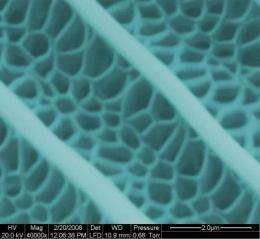Nanometric butterfly wings created

A team of researchers from the State University of Pennsylvania (USA) and the Universidad Autónoma de Madrid (UAM) have developed a technique to replicate biological structures, such as butterfly wings, on a nano scale. The resulting biomaterial could be used to make optically active structures, such as optical diffusers for solar panels.
Insects' colours and their iridescence (the ability to change colours depending on the angle) or their ability to appear metallic are determined by tiny nano-sized photonic structures which can be found in their cuticle. Scientists have focused on these biostructures to develop devices with light emitting properties that they have just presented in the journal Bioinspiration & Biomimetics.
"This technique was developed at the Materials Research Institute of the State University of Pennsylvania and it enables replicas of biological structures to be made on a nanometric scale", Raúl J. Martín-Palma, lecturer at the Department of Applied Physics of the UAM and co-author of the study explains to SINC.
The researchers have created "free-standing replicas of fragile, laminar, chitinous biotemplates", that is, copies of the nano structures of butterfly wings. The appearance of these appendices usually depends more on their periodical nanometric structure (which determines the "physical" colour) than on the pigments in the wings (which establish the "chemical" colour).
In order to create new biomaterial, the team used compounds based on Germanium, Selenium and Stibium (GeSeSb) and employed a technique called Conformal-Evaporated-Film-by-Rotation (CEFR), which combines thermal evaporation and substrate rotation in a low pressure chamber. They also used immersion in an aqueous orthophosphoric acid solution to dissolve the chitin (substance typically found in the exoskeleton of insects and other arthropods).
The methods used to date to replicate bio structures are very limited when it comes to obtaining effective copies on a nanometric scale and they often damage the original biostructure because they are used in corrosive atmospheres or at high temperatures. The new technique "totally" overcomes these problems, as it is employed at room temperature and does not require the use of toxic substances.
Martín-Palma points out that the structures resulting from replicating the biotemplate of butterfly wings could be used to make various optically active structures, such as optical diffusers or coverings that maximise solar cell light absorption, or other types of devices. "Furthermore, the technique can be used to replicate other biological structures, such as beetle shells or the compound eyes of flies, bees and wasps," the researcher says.
The compound eyes of certain insects are sound candidates for a large number of applications as they provide great angular vision. "The development of miniature cameras and optical sensors based on these organs would make it possible for them to be installed in small spaces in cars, mobile telephones and displays, apart from having uses in areas such as medicine (the development of endoscopes) and security (surveillance)", Martín-Palma says.
More information: Akhlesh Lakhtakia, Raúl J. Martín-Palma, Michael A. Motyka y Carlo G. Pantano. "Fabrication of free-standing replicas of fragile, laminar, chitinous biotemplates". Bioinspiration & Biomimetics 4 (3): 034001, Sept 2009.
Source: FECYT - Spanish Foundation for Science and Technology


















